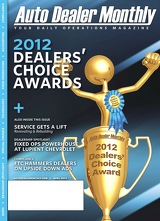Auto Dealer Monthly Magazine is the daily operations publication serving the retail automotive industry. This automotive publication serves dealer principals, officers and general managers with the latest best practices.
Page 17 of 62
industry expert / technology
Showing up on Google's first page isn't enough. Your dealership needs customers to bring their cars and trucks into your service bays.
update a service-oriented blog within your website, it can quickly improve your competi- tive standing against these brands. If you are cost-competi- tive, you should build out "Dare to Compare" pages for some of your most compelling offers and in corporate those into your marketing efforts.
Showing up on Google's first page isn't enough. Your dealership needs customers to bring their cars and trucks into your service bays. The calls to action appropriate for your service department are completely different than the lead forms on your current dealership site. You want to generate calls, appointments, coupon prints, chats, etc., because the buying cycle for someone getting brake service is days or hours, not weeks or months. You are not looking to capture email addresses from these consumers so you can nurture them over time; you're trying to get them into your service bays this after- noon. Every page on your dedicated service website should be focused on driving service-type conversions, not traditional leads.
Once you have strong online content that markets your fixed ops with the appropriate calls to action, you can begin fighting the national brands with paid search campaigns. Make sure your campaign landing pages incorporate the appropriate conversion elements (phone numbers, coupons, chat and service- scheduler tools) so you get the full value of your paid search
15
spending. The search terms consumers use for service are different from those they use to shop/research vehicles. For ex- ample, "coupons" and "offers" are some of the most important keywords for service-related searches. Incorporating these types of phrases into your landing page and ad copy is imperative.
The pay-per-click (PPC) campaign must be separate from your campaigns on the dealership website. Create different keyword sets and in- clude service-related negative keywords in search campaigns for your primary dealership site (you don't want service-related traffic seeing your new and used vehicle ad copy). Track your conversions at the key- word level, and if possible, tie your PPC to your DMS in order to truly optimize for ROI.
Service-related business also requires a different set of data to be tracked and reported. The reporting on your service site needs to mirror the goals for your site. You need to be able to track phone calls, coupon prints, appointments set and chat leads, ideally in a way that
ties back to marketing (SEO, PPC, email) via analytics. As you create your stand-alone service site, make sure you build out this capability or use a provider that can do this for your dealership.
Finally, email marketing to your current customer base can be an extremely profitable way to generate ROs. To maximize your return on email cam- paigns, send your email traffic to landing pages that mirror the email offer and incorporate all of the appropriate calls to action. Make sure to collect current email addresses for everyone who comes through your service department.
Studies have shown that a customer with a valid email address in your DMS (so you can market to them) will generate 20 percent more service revenue over the life- time of their vehicle.
Whether or not you decide that a stand-alone service website is the right course for your dealership, you need to start allocating a much larger share of your online/digital marketing budget to your fixed opera- tions. If you don't, you will effectively be abandoning the battlefield and surrendering to the national service brands for your customers' future service business.
